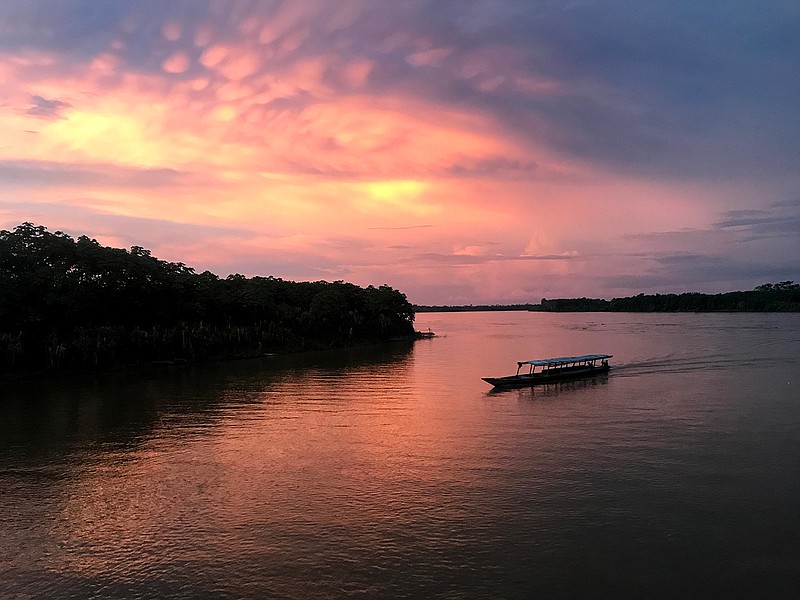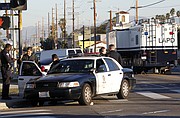As the boat glided down the Amazon River, I swung from a hammock and watched the seemingly endless jungle pass by. I was entranced; I'd never seen so many shades of green in one place. I had come to witness the Amazon rainforest firsthand, and it was already putting on an amazing show.
Commanding 2.3 million square miles, the rainforest is one of the most biologically diverse places on the planet, home to millions of species of plants, animals and insects, many of which have yet to be identified by scientists.
Thanks in part to the rubber boom of the late 1800s, it's accessible to visitors through a handful of port towns that dot the edges of a few of the thousands of rivers that weave through the jungle. One of the best of those towns for basing a visit to the Amazon is Iquitos, Peru - which, at more than 400,000 people, is actually a city. Aside from one highway that runs between it and a smaller nearby port town, there are no roads connecting Iquitos to the outside world. The only way into and out of the city is by plane or boat.
While most people opt for the under-two-hour flight from Lima or a day-long speedboat ride from a town reachable by car, I decided on a more uncommon approach to Iquitos: a three-day cruise via cargo ship.
I learned that cargo ships were an Amazon River basin transportation option from a German couple I met while traveling in South America with my husband. It sounded so romantic. We'd find a boat with room for us and spend a few days drifting along two tributary rivers before meeting up with the world-famous Amazon River. Flanked by wild jungle, I would take in the first sights and sounds at a slow, relaxed pace. Thankfully, we're flexible travelers and were on a leisurely schedule, because you can't book these trips in advance, and schedules are uncertain. Just traveling from the northwestern city of Trujillo, where we'd enjoyed some beach time, to Yurimaguas, the Peruvian river-port town from which the cargo ships depart, required a 20-plus-hour bus ride followed by a two-hour ride in a colectivo, essentially a shared taxi. (Most travelers get to Yurimaguas via the north-central city of Tarapoto.)
When my husband and I arrived in Yurimaguas, we went straight to the central market to buy supplies for the cruise: hammocks and mosquito nets to drape over them; bowls for our meals aboard the ship; lots of bottled water; and snacks to get us by should the food look dodgy.
Then we headed for the port - or so we thought. It turns out we were at the wrong one; no cargo ships were leaving from it. When we reached the correct port in the northeast corner of town, which our mototaxi driver called Enapu, we saw a flurry of activity. The small dock, which could more accurately be described as a slab of flat shoreline that abuts the river, had enough space for a handful of boats. Using slats of wood as ramps from the muddy ground, men carried armfuls of watermelons, bags of rice, furniture, electronics and live animals onto two docked cargo ships.
After talking to a man in an authoritative-orange vest, I discovered that only one boat, the Kiara I, would let us aboard. (The Eduardo VIII docked next door had filled two entire decks with live chickens and wasn't taking on any human passengers.)
In between the activity, we slipped onto the Kiara I and strung our hammocks between rusty holes in the ceiling of the open-air deck at the stern of the boat. This would be our sleeping area for the journey.
Once we got situated, we waited. While cargo boats in the area regularly allow travelers passage for a fee (we paid the equivalent of about $30 apiece, which included meals), the cargo is the priority and the boat would only leave once the 200-foot-long ship was full. That, however, was a difficult thing to determine. Asking three crew members about the departure time elicited three different responses, which did nothing to ease my fears of being left behind.
I had been warned that it could take a few days to embark, so this really only became a problem when we wanted to leave the ship to get lunch or dinner (meals were covered only when we were moving). I decided the best way to determine whether we had enough time to leave was to look at the cargo - if there was still a good amount of product to unload from a truck onto the ship, it felt safe to leave the ship for a few hours.
To pass the time, I chatted with our hammock-mates. Of the roughly 50 passengers, about 10 were international travelers like us, and the rest were locals. Through my conversational Spanish, I learned that some of the locals were related to the crew and others were just going between towns after doing business or visiting family.
Simply sitting on the docked boat was surprisingly enjoyable. At one point, a pod of dolphins splashed around our ship for a few hours. Some were the pink dolphins that are famous in the Amazon, which prompted awws from all the non-Peruvians. We were also thoroughly entertained by the nearby chicken boat. One by one, several chickens (presumably bound for the dinner table) jumped overboard. They bobbed away with the current of the river, prompting both cheers for the birds that were making a bid for freedom and a debate about whether chickens could swim.
By the time the boat finally left, we'd spent a total of 36 hours - including two full nights - on the docked ship. But once we got going, any frustration born from delay dissipated. The gentle, warm breeze and the sights and sounds of the Amazon made for a tranquil experience. Over the low rumble of the ship's engine, I heard a choir of birds chirping and the sound of crickets screeching. Trees thick with vines were so dense that there was no way to see much farther than the water's edge.
Every so often, the green of the forest was broken up by stilted thatched houses. As the boat slowly passed, I captured glimpses into the lives of those who called the Amazon home: a young woman washing clothes, boys playing soccer in a field, young men loading bananas onto a long wooden boat.
The rivers we traveled are a milky brown color that I later learned comes from sediment. While that made the waters appear dirty, various pieces of floating garbage added to the impression. It was painful to see some of the crew members throw their trash into the water. At one point, I watched as a man on our boat struggled to re-secure a tarp draped over some cargo, only to toss the tarp overboard a few minutes later, seemingly out of frustration.
The accommodations - which included the option of a few cabins, though everyone chose hammock space given the heat - were about what you'd expect from a cargo ship; water pooled in parts of the rusty deck, and spiders came out in droves at night. At one point, I spotted a fat, several-inch-long black beetle that sent me running. A Peruvian girl, who couldn't have been more than 5 years old, picked it up and moved it away from me without flinching, leaving me feeling as though we'd swapped our child-adult roles.
The bathrooms were awful. The floor was constantly covered with about an inch of standing water. The toilet had no seat and didn't flush, so waste had to be washed down with a bucket and seemingly flowed into the river. A pipe hanging from the ceiling in the middle of the room was used to fill the bucket. It also doubled as a shower, which I couldn't bring myself to use. Thankfully, I had thought to pack baby wipes, which I used every day. Even so, I was grimy.
The meals were tastier than I expected, though a bit odd and lacking in variety. One lunch consisted of chicken, rice and potatoes, while another was essentially the same ingredients but in soup form. For dinner, we were served a sweet, cinnamon-flavored milky soup with bits of rice floating in it. If you closed your eyes and imagined a mug instead of a bowl, it would have made a decent after-dinner by-the-fire beverage. For breakfast, we were served chicken soup one morning and the milk soup another.
Between watching the scenery go by and chatting with other passengers, I also filled the days lying in my hammock reading. Each night on board, the international passengers crowded around a small headlamp and played various games. I had packed a small bottle of rum, which got passed around, and that, along with some translation-induced hilarity, had us laughing into the night.
By the end of the second day, our boat reached Nauta, the small town that connects to Iquitos by road. Here, a lot of locals got off. A bus to Iquitos would take only about two hours, rather than the eight hours left to go via boat. Having gone four days without showering, the idea of getting to my destination more quickly was pretty appealing. But, after buying some beer and snacks, all the international travelers got back on the boat and gathered on the topmost deck above the wheelhouse. We just weren't done with our journey.
Surrounded by strangers turned friends, I watched as the blue sky faded to oranges and pinks that deepened as the sun set. A feeling of contentment washed over me. I had grown to appreciate how time seemed to move differently on the boat. The smallest moments and simplest observations were enjoyed in full, because we had nowhere else to be and nothing else competing for our attention.
Early the next morning, we drifted into the port at Iquitos. Groggy but excited to have finally made it, we exchanged contact information and went our separate ways.
Overall, the trip was immensely satisfying. The slow pace allowed me to really get to know my neighbors. Everyone on the Kiara I came from different walks of life, but on the ship, we were all equal. We were confined to the same space, ate the same meals at the same time and suffered through the same mosquito-filled, air-condition-less heat together. It was a humbling reminder that we're all the same - no better or worse than anyone else in this world.
Choosing to take this journey is like choosing to hand-write a letter. Modern technology has made it easier and quicker to type out an email, but putting pen to paper forces your brain to slow down, making ideas flow differently. It's more therapeutic and, in my opinion, more meaningful.
With traveling, we've made it easier to reach far-flung places, but I'm starting to wonder if we lose something when we jet around from place to place. Sometimes, I think the slow boat is exactly what we need.
FROM YURIMAGUAS TO IQUITOS BY CARGO SHIP
Cargo ships to Iquitos leave Yurimaguas year-round and can be reached via the city of Tarapoto, about 600 miles northeast of Lima. A bus from Lima to Tarapoto should take about 24 hours and cost about $30; a flight should take about an hour and 15 minutes and cost about $150. From Tarapoto, take a colectivo (shared taxi) to Yurimaguas, which should take about two hours and cost about $5. In Yurimaguas, take a mototaxi to the Enapu-Yurimaguas Port Terminal in the northeast corner of the city. Once you arrive at the dock, ask around for which cargo ships are accepting passengers and pay the captain for your passage and onboard meals, about $30. (If you haven't already bought a hammock and food, take a mototaxi to the central market before heading to the port.) Cargo ships don't adhere to a schedule, leaving only when they are full, so departure could take a few days. To return to Lima, flights from Iquitos leave daily and cost about $65.



